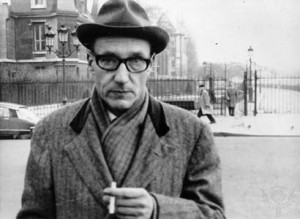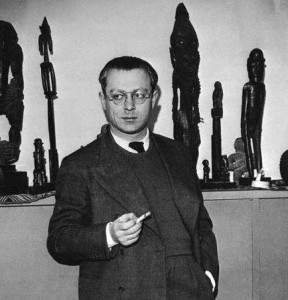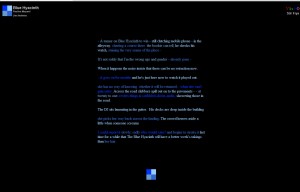
[In this post: Blue Hyacinth]
 Â
Â
Let’s play a little trivia quiz and try to answer my question. I’ll give you some clues:
- The man on the left is William Burroughs, a famous American writer. His biografy is pretty interesting, if you consider that he moved to South America only to get a special drug which was supposed to gift the user with telepaty, committed an homicide and was a great friend of Jack Kerouac. His most famous work is Naked Lunch, which was written according to a particluar tecnique…
- The other man is Tristan Tzara, one of the founders of the Dada movement. Among the manifestos which appeared in the collection Les sept manifestes Dada, you should pay attention to one in particular, called Dada Manifeste sur l’Amour Faible et l’Amour Amer (Dada Manifesto on Feeble Love and Bitter Love). In the section VIII of this manifesto, Tzara gives the instructions for making a dadaist poem. The “raw material” for a dadaist poem is…
- The tecnique used by the English rockband Radiohead to write some of the songs contained in their album Kid A follows faithfully the method pursued by Burroughs, who evidently enough had in mind Tzara while writing Naked Lunch…
Is everything clear now?
What Tzara, Burroughs and the Radiohead with Kid A’s lyrics do is creating new texts starting from existing texts. They are chunked in small parts, according to the words or the sentences that compound them, then randomly selected and recombined together.
Tzara used to choose an article from a newspaper, cut the words and pick one by one after “shaking gently” them into a hat. Burroughs did something similar for a whole novel. The Radiohead mixed up verses in a hat and then put them together to form new songs.
The same recombination of words we can find in Blue Hyacinth, by Jim Andrews and Pauline Masurel. The dominating color is, of course, blue and its various shades. Clicking on one of the four squares you can choose the starting blue but then, mousing over the text, its phrases and sentences change their shade of blue and their words, too. The mechanism which underlies under this transformation is called “stir fry”. Basically it’s the same thing as Tzara & C. but transported into a computer, so that the recombination of the various chunks is immediate and constantly mutable, and the total amount of the possible new texts that can be generated is impressively high.
The effort that is required to read it is I think as tough as the one they put in writin it. The basic texts from which the cuts come from had to be built so that “the syntax is usually still fluid after deranging the text”. I guess it’s not easy to find the perfect formula to create coherent texts out of other texts which are virtually teared apart and glued together again.
PS: I’d like to add a couple of things before moving onto the next post. First of all: my grandmother used to have a blue hyacinth in her garden. When I was a child I was really fond of gardening – read: uprooting every kind of flower that appealed my sight and fascinated my nose with its smell. I was a pretty generous girl too, so I usually gave these flowers to my mother and my aunt as presents. I used to give flowers to my grandmother too, but she didn’t seem like she really appreciated my green thumb.
But anyway, I’ve always had a kind of sacred awe of hyacinths. If they aren’t in our garden anymore is our cat’s fault, not mine.
Secondly, if you want to try and create your own dadaist poem but all of sudden you realize that you dont’t have the appropriate tools, try this. (I strongly recommend to try to do it with your own hands, though. I know I am writing about electronic literature, but the pleasure of creating something out of glue and paper and messing around words is absolutely incomparable).



I’m glad you enjoyed the blue hyacinth stir fry. You might also be interested in the original, six-month blue hyacinth journal that I kept online and which was the source for the texts in the stir fry version.
http://www.unfurling.net/bluehyacinth/
Every so often, completely unknowing that I spent so long obsessing about them, people will give me a blue hyacinth bulb as a gift.
Pauline Masurel
Hi Pauline!
I’m glad you found me!
I’ve found your stir fry Blue Hyacinth really fascinating. For some aspects, especially the way in which the lines overlap and perfectly match together, it reminds me of Queneau’s 100 Thousand Billion Poems. Were you inspired by it in some ways? And what about Michael Joyce’s “Twelve Blue” and his source of inspiration, “On being blue” by William Gass? Did they influence you in some ways?
I’m really interested in your work, and the journal you were keeping online – I think – shows how the Internet allows new forms of communication and also of self-exploration, too. Even though I am sure that ink and paper will never totally disappear from our culture, I believe that the sense of owning a space only for your own but ready to be shared with the rest of the world is absolutely unique.
Thank you again for your comment! Let’s pretend I’m personally giving you a bunch of Sunflowers, I think they can get along very well with your beautiful Blue Hyacinth!
Beniamina